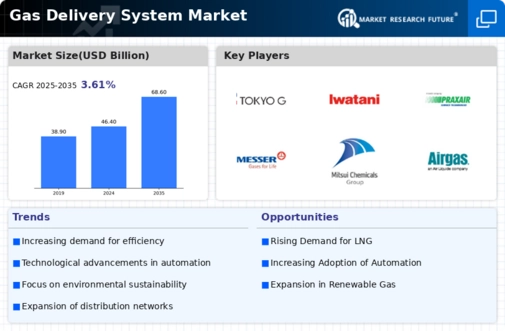Market Growth Projections
The Global Gas Delivery System Market Industry is poised for substantial growth, with projections indicating a market value of 46.4 USD Billion in 2024 and an anticipated increase to 68.6 USD Billion by 2035. This growth trajectory reflects a compound annual growth rate (CAGR) of 3.61% from 2025 to 2035. The increasing adoption of natural gas across various sectors, coupled with technological advancements and supportive government policies, is likely to drive this expansion. Stakeholders are expected to capitalize on emerging opportunities, ensuring that the gas delivery systems evolve to meet the changing demands of the global energy landscape.
Increasing Demand for Natural Gas
The Global Gas Delivery System Market Industry is experiencing a notable surge in demand for natural gas, driven by its cleaner combustion properties compared to coal and oil. As countries strive to reduce carbon emissions, natural gas is increasingly viewed as a transitional fuel towards a more sustainable energy future. In 2024, the market is projected to reach 46.4 USD Billion, reflecting a growing preference for natural gas in power generation and industrial applications. This trend is particularly evident in regions such as Asia-Pacific, where rapid urbanization and industrialization are propelling the demand for efficient gas delivery systems.
Government Initiatives and Regulations
Government policies and regulations aimed at promoting cleaner energy sources are significantly influencing the Global Gas Delivery System Market Industry. Many governments are implementing incentives for natural gas usage, including subsidies and tax breaks, to encourage its adoption over more polluting fuels. Additionally, regulatory frameworks are being established to ensure the safe and efficient operation of gas delivery systems. This supportive environment is likely to foster market growth, as stakeholders align their strategies with national energy goals. The anticipated CAGR of 3.61% from 2025 to 2035 underscores the potential for sustained investment in this sector.
Infrastructure Development and Investment
Infrastructure development is a critical driver for the Global Gas Delivery System Market Industry, as aging pipelines and distribution networks necessitate significant upgrades and expansions. Governments and private entities are increasingly recognizing the need for robust gas infrastructure to meet rising demand. Investments in new pipeline projects and the modernization of existing systems are expected to enhance the reliability and efficiency of gas delivery. This trend is particularly pronounced in emerging economies, where rapid population growth and urbanization are driving the need for comprehensive gas infrastructure solutions. Such developments are likely to support the market's growth in the coming years.
Technological Advancements in Gas Delivery
Technological innovations are playing a pivotal role in enhancing the efficiency and safety of gas delivery systems within the Global Gas Delivery System Market Industry. The integration of smart technologies, such as IoT and advanced monitoring systems, allows for real-time data analysis and improved leak detection. These advancements not only optimize operational efficiency but also ensure compliance with stringent safety regulations. As a result, companies are increasingly investing in upgrading their infrastructure, which is expected to contribute to the market's growth trajectory, with projections indicating a market value of 68.6 USD Billion by 2035.
Rising Industrial Applications of Natural Gas
The industrial sector's growing reliance on natural gas as a feedstock and energy source is a key factor propelling the Global Gas Delivery System Market Industry. Industries such as chemicals, fertilizers, and manufacturing are increasingly utilizing natural gas for its cost-effectiveness and lower environmental impact. This trend is expected to continue, with natural gas serving as a vital component in various industrial processes. As industries strive for sustainability and efficiency, the demand for reliable gas delivery systems is anticipated to rise, further contributing to the market's expansion. The projected growth in industrial applications underscores the importance of this sector in shaping the future of gas delivery.












